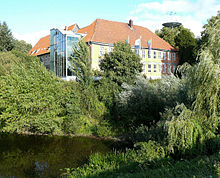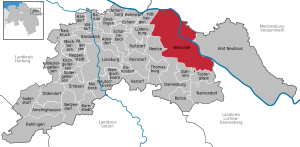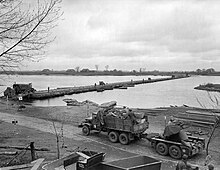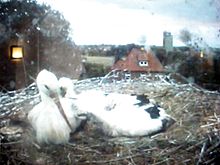Bleckede
| coat of arms | Germany map | |
|---|---|---|

|
Coordinates: 53 ° 17 ' N , 10 ° 44' E |
|
| Basic data | ||
| State : | Lower Saxony | |
| County : | Luneburg | |
| Height : | 6 m above sea level NHN | |
| Area : | 140.5 km 2 | |
| Residents: | 9471 (Dec. 31, 2019) | |
| Population density : | 67 inhabitants per km 2 | |
| Postcodes : | 21354, 19273 | |
| Primaries : | 038844, 05852, 05853, 05854, 05857 | |
| License plate : | LG | |
| Community key : | 03 3 55 009 | |
City administration address : |
Lüneburger Strasse 2a 21354 Bleckede |
|
| Website : | ||
| Mayor : | Dennis Neumann (non-party) | |
| Location of the city of Bleckede in the Lüneburg district | ||
Bleckede [ ˈbleːkədə ] is a small town on both sides of the Elbe in the district of Lüneburg in Lower Saxony .
geography
Geographical location
Bleckede lies mostly in the glacial valley of the Elbe, some districts also a little higher on the Geestrücken up to 160 m above sea level . The entire urban area is part of two national natural landscapes , the Lower Saxony Elbe Valley Biosphere Reserve and the Elbhöhen-Wendland Nature Park .
City structure
In addition to the core town, Bleckede consists of other districts (as of 2005): Alt Garge , Barskamp , Brackede , Breetze , Garlstorf , Garze , Göddingen (with Nindorf ), Karze (with Vogelsang ), Radegast , Rosenthal , Walmsburg (with Reeßeln ), Wendewisch and the district of Bleckede-Wendischthun on the right Elbe with the villages of Neu Bleckede and Neu Wendischthun .
Neighboring communities
| Integrated community of Scharnebeck |

|
Municipality of Neuhaus |
| Integrated community of Ostheide | Integrated community of Dahlenburg |
Joint municipality Elbtalaue district Lüchow-Dannenberg |
history


Beginnings
In the course of flood protection measures, Alt Wendischthun was diked in 2008. The removal of the topsoil in the Deichtrasse led to the discovery of a Bronze Age settlement.
After the fall of Henry the Lion , the Guelphs lost control of the Artlenburg Elbe crossing and Bardowick's trade routes towards the end of the 12th century . Bleckede was therefore founded as a city in 1209 by Duke Wilhelm of Braunschweig and Lüneburg as a new trading center under the name Löwenstadt / Lowenstat on the Elbe . The name chosen in memory of Henry the Lion did not catch on. The place name Bleckede is probably due to the old Germanic “Blek-ithi”, blek and -ithi mean here bright, free, clear place , and arose from the earlier German and Wendish settlement Bleketsa and slavicum Bleckede .
City rights and fortification of the place
In 1293 Bleckede, which was not officially a city at that time, was granted the right to mint together with other cities . It was not until 1310 that Bleckede was officially granted town charter with the condition that the town be fortified. This purpose was fulfilled by a moat that marked the city limits until 1929.
For personal protection, to secure the Elbe toll and Elbe crossing, the construction of a castle in Bleckede was probably started in the 13th century. The Elbe Castle Bleckede , built around 1600, stands on the remains of the castle, the oldest mention of which is known around 1270. In 1379 Bleckede Castle was ceded to the cities of Hamburg, Lübeck, Hanover and Lüneburg, after which Lüneburg succeeded in having Bleckede's possession confirmed by Easter 1561.
Since the beginning of the 17th century
From 1593 until his death in 1623 Fritz von dem Berge was the bailiff of Bleckede. In 1666, a conflagration laid the entire town of Bleckede in ruins. In 1720 the first doctor came to Bleckede and in 1735 the old pharmacy , which is still preserved today, was built.
From April 1, 1885, Bleckede was the district town of the newly founded Bleckede district , which was reintegrated into the Lüneburg district on October 1, 1932.
Establishment of a marine supply depot at the end of the First World War
Since the war years 1917/18 , the Imperial Navy had the oil farm built in Bleckede. From 1936/37 construction activity was particularly intense. Oil stocks were stored on a 150 hectare site. The total capacity was approx. 340,000 t. An extensive tunnel system connected all 34 giant underground bunkers. For storage and loading, underground pressure pipelines led via pumping stations to the Elbe. In total, the warehouse consisted of 78 tank and building systems. Three years after the end of the war, the facilities were dismantled and blown up in 1948. Around 12,000 m of pipelines, plant components and other scrap were shipped to England. From 1960 to 1968 the debris was leveled.
Construction of the Alt-Garge coal-fired power station by concentration camp prisoners during the Second World War
The Hamburgische Electricitäts-Werke (HEW) began building a coal-fired power plant in the Alt-Garge district, directly on the Elbe , during the National Socialist era . For the construction of the coal-fired power station Alt-Garge of the Hamburgische Electricitäts-Werke (HEW), since 1940 mainly forced laborers who were housed in an external camp ( camp "A" ) have been used. In 1944, a new camp complex was built in the vicinity of the construction site, which was operated as the Alt Garge concentration camp branch ( branch of the Neuengamme concentration camp ) and was intended to replace the first camp. Until February 1945, forced laborers from Neuengamme and Sachsenhausen concentration camp were sent to the Alt Garge satellite camp .
The first power plant block was only connected to the grid after the war, in 1946 with 70 megawatts. In the 1970s there were considerations to build a nuclear power plant in Alt Garge. In 1974 the coal-fired power station was finally shut down. In 1987/88 the power plant's facilities were dismantled. Remnants of the systems are still visible. In the vicinity of what was then the Alt-Garge concentration camp external command, a memorial commemorates the fate of the prisoners.
At the end of the Second World War
Germany lost World War II in 1945 and it was gradually occupied. In the last days of the war, the Allied troops moved further and further north. On April 29, 1945, ten kilometers from Bleckede, the British troops crossed from Artlenburg to the opposite bank of the Elbe near Schnakenbek , set up a bridgehead and then occupied the nearby town of Lauenburg in order to advance to Schleswig-Holstein from there . Shortly afterwards, on the night of April 30 to May 1, 1945, units of the 9th United States Army crossed the Elbe at Bleckede with the help of a pontoon bridge . 86 people died in the fighting to cross the Elbe near Bleckede. This was followed by the occupation of southwestern parts of Mecklenburg by the Americans, their meeting with the Russians near Lübz and a joint victory celebration by the two allies on May 3, 1945.
One day before this victory celebration, the executive government of the Reich fled from the Eutin - Plön area 90 kilometers to the north from the approaching British troops to Flensburg - Mürwik . On the day of the victory celebration, British soldiers also marched into Hamburg to the west . On May 4th, all German troops in north-west Germany, the Netherlands and Denmark were finally capitulated .
Incorporations
As part of the administrative and territorial reform, the unified municipality of the city of Bleckede was formed on March 1, 1974. By concluding an area change agreement, the previously independent municipalities of Alt Garge, Barskamp, Brackede, Breetze, Garlstorf, Garze, Göddingen, Karze (with Vogelsang), Radegast, Rosenthal, Walmsburg (with Reeßeln) and Wendewisch became the only municipality in the district of Lüneburg until then summarized.
During the division of Germany , the right-Elbe districts of Neu Bleckede and Neu Wendischthun were within the German Democratic Republic . Like Mödlareuth, the city was divided into Thuringia and Bavaria . As a result of German reunification , the two localities that belonged to the municipality of Teldau became districts of the city of Bleckede again and the entire Neuhaus district became part of the Lüneburg district again. This reclassification took place on June 30, 1993.
religion
There are various Christian denominations in Bleckede .
Bleckede is the seat of an Evangelical Lutheran church district, it belongs to the Lüneburg district of the regional church of Hanover. The parish of St. Jacobi in Bleckede includes the 18th century church on Zollstrasse, a day-care center and the Bleckede cemetery. Jörg Immendorff was baptized in 1946 in the St. Jacobi Church.
The Catholic Church of St. Mary Queen of St. Rosary was erected in 1968. It is a parish church in the dean's office in Lüneburg, and the churches in Dahlenburg and Neuhaus are also assigned to it.
The non-Trinitarian Jehovah's Witnesses own a Kingdom Hall in the city.
politics
The city of Bleckede belongs to the state electoral district 48 Elbe and to the federal electoral district 38 Lüchow-Dannenberg - Lüneburg .
City council
The city council of Bleckede consists of 24 council women and councilors. This is the specified number for a municipality with a population between 9001 and 10,000 inhabitants. The 24 council members are elected by local elections for five years each. The current term of office began on November 1, 2016 and ends on October 31, 2021.
The full-time mayor Jens Böther (CDU) is also entitled to vote in the city council.
The last local election on September 11, 2016 led to the following result:
| Party / list | Share of votes | +/-% p | Seats | +/- |
| CDU | 40.11% | + 9.3 | 10 | + 3 |
| SPD | 16.71% | - 1.8 | 4th | - 1 |
| Green | 14.33% | + 1.0 | 3 | ± 0 |
| UWB * | 28.85% | + 12.0 | 7th | + 3 |
| FDP | - | - 3.2 | - | - 1 |
| Flat share Bleckede (WB) | - | - 17.4 | - | - 4th |
* Bleckede independent voter group
The turnout in 2016 was 55.29%.
mayor
The full-time mayor of the city of Bleckede has been Jens Böther (CDU) since 2006. In the last mayoral election on May 25, 2014, he was re-elected as incumbent with 60.8% of the vote. His opponent Martin Gödecke (Independent Voting Group Bleckede) received 39.2%. The turnout was 52.3%. Böther took up his further term in office on November 1, 2014, but was elected District Administrator of the Lüneburg district in 2019.
Town twinning
A partnership with the French municipalities of Auffay and Tôtes has existed since 1977 . Both French municipalities were part of the canton of Tôtes in the Seine-Maritime department in the Normandy region until 2015 .
Culture and sights
- Protestant St. Jacobi Church
- former castle / former official residence / folk high school
- former district court
- stately half-timbered houses:
- Breite Strasse 15, No. 51
- Friedrich-Kücken-Strasse
- Schlossstrasse 3
- Jewish cemetery (Bleckede)
Economy and Infrastructure
economy
In addition to many craft businesses and small businesses, Bleckede has several medium-sized industrial companies. The largest are Atlantic Multipower Germany (formerly ELBA Lebensmittel), Horst Witte Gerätebau, Snowfoot + Rohde and Meyer Motoren; the largest construction company is Hoppe, the local energy supplier and largest electrical company is Energieversorgung Dahlenburg-Bleckede AG. In addition, there is the medium-sized company ZVN Zellstoff-Vertrieb Nord GmbH, which sells hygiene products throughout Germany.
tourism
Bleckede is located on the following long-distance cycle routes: Elbe Cycle Route , Mecklenburg Lake Cycle Route and German-German Cycle Route . There are numerous accommodation providers, campsites and dining facilities marked by the ADFC available to visitors. The city is characterized by its location on the Elbe, the port is still called by cargo ships and is berth for pleasure boats. The Bleckede – Neu Bleckede ferry shuttles across the river. Various passenger ships call at the port, including the historic paddle steamer Kaiser-Wilhelm.
Due to the many well-preserved half-timbered houses, some of which have attractive front doors, Bleckede is part of the German half-timbered road on the regional route “From the Elbe Valley to the Harz ”. The German Storchenstrasse has also been running through Bleckede since 2008 , initiated by the Elbschloss Bleckede , the information center for the Lower Saxony Elbe Valley Biosphere Reserve . A special eye-catcher is the stork's nest in the city center on a chimney that is out of order and is occupied every year. There is also a video camera that sends recordings of the nest life directly into the castle. The Elbschloss Bleckede is currently being expanded into the future Elbe Valley floodplain biosphere with an aquarium landscape and a beaver enclosure.
The following holiday routes also lead through Bleckede : Lower Saxony Asparagus Route , Lower Saxony Mühlenstrasse and the European Route of Brick Gothic . Hikers pass through the small town on the Elbe on the European long-distance hiking trail E6.
The city of Bleckede can also be reached with a historic railway, the Heide-Elbe-Express ( Lüneburg – Bleckede railway ). In addition, a bicycle trolley runs between the Alt Garge and Bleckede districts. The Alt Garge forest pool, regular balloon rides from Schützenplatz and an extensive regional network of cycle paths and routes for inline skaters complete the offer.
media
The daily newspaper Bleckeder Zeitung appears in the unitary community Bleckede, the Neuhaus office and the Lüneburg district. It was founded over 130 years ago. This paper is now published Monday and Thursday.
education
There are two primary schools in Bleckede, the Elbtal primary school and the primary school in the Barskamp district , as well as a secondary and a secondary school, and the Bleckede grammar school has existed since 2006; these three schools are all located in the Bleckede school center in the Nindorfer Moorweg and have two sports halls and a swimming pool. There is also the Kurt Löwenstein School, a special needs school with a focus on learning.
Bleckede is the location of one of only two customs dog schools nationwide , the other location is Neuendettelsau . The real estate and the buildings are shared with the Federal Police , which also have their dog schools there.
traffic
- Road traffic
Bleckede is connected to Lüneburg via the L 221 state road. You can cross the Elbe by ferry, where the L 223 continues.
- Public transportation
Bleckede is connected to Lüneburg via the 5100 bus of the North East Lower Saxony transport association. Other bus routes lead to Neu Darchau , Hittbergen , Dahlenburg , Scharnebeck and Neetze .
- Rail transport
Bleckede is located on the Lüneburg – Bleckede railway line ( Bleckeder Kleinbahn , as of 2017 no regular passenger traffic) and used to be located on the Bleckeder Kreisbahn (Dahlenburg – Echem).
Personalities
Honorary citizen
- Hermann Brandes (1885–1972), General Director of the Niedersächsische Landesbank in Hanover
- Honorary Mayor
- Wilhelm Nürnberg (since December 18, 1973)
- Medal of Honor of the City of Bleckede
- August Karstens, 2008
- Otto Telschow (1876–1945, NSDAP Gauleiter), former honorary citizen. Honorary citizenship since April 25, 1933, revoked on October 30, 2008.
sons and daughters of the town
- Fritz von dem Berge (1560–1623), captain at Bleckede Castle, made himself a. a. earned for dike security in the Elbe city.
- Friedrich Wilhelm Kücken (1810 in Bleckede - 1882 Schwerin), German composer.
- Auguste von der Elbe (owned by von der Betten, née Meyer), (1827 Bleckede Castle - 1908 Hanover), German writer.
- Ernst Christian Julius Schering , (1833 Forsthaus Sandbergen / Bleckede - 1897 Göttingen), German mathematician and editor.
- Hermann Collitz (* 1855 in Bleckede, † 1935 in Baltimore, USA), American linguist
- Wilhelm Kröpcke , from 1876 to 1919 manager of the Café Kröpcke in Hanover , * 1855 in Bleckede, † 1919 in Bad Kissingen .
- Gustav Schwantes , prehistoric and early historian, biologist and polymath, * 1881 in Bleckede, † 1960 in Hamburg.
- Kurt Löwenstein , SPD politician, member of the Reichstag, * 1885 in Bleckede, † 1939 in Paris.
- Hawoli , painter and sculptor, * 1935 in Bleckede.
- Friedrich-Wilhelm Bach , engineering scientist, professor at Leibniz University Hannover, * 1944 in Bleckede, † 2014.
- Jörg Immendorff , (1945 Bleckede - 2007 Düsseldorf), German painter, professor in Düsseldorf.
- Jörg Bergstedt , German eco-activist, author and anarchist , * 1964 in Bleckede.
Personalities who have worked in this city
- Gerhard Fietz , (* 1910 in Breslau, † 1997 in Bleckede, district Göddingen) painter and founding member of " ZEN 49 "
- Frieder Gadesmann , (* 1943 in Celle), Protestant theologian and educationalist, teacher and city councilor in Bleckede
- Stefanie Dahle , (* 1981 in Schwerin), children's book author and illustrator
literature
- Festival committee of the city of Bleckede (Ed.): 750 years of Bleckede . Bleckede 1959
- Ute Schötteldreyer: Bleckeder Heimatbuch. From the history of the city of Bleckede and its history . Edited by Bleckeder Zeitung, Bleckede 1983, 370 pages
- Ute Schötteldreyer: Hjalmar Schacht, President of the Reichsbank and Minister of Economics. Sketches of his life, which also led him to Bleckede . Edited by Bleckeder Zeitung, Bleckede 2006, 66 pages
- Werner H. Preuss (ed.): Bleckede magazine . Bleckede 2009, ISBN 978-3-923603-04-6 .
- Hans-Jürgen Hammacher: Bleckede for the curious. A little city history . Bleckede 2010
Web links
- Information about the city of Bleckede
- Information on the history of the Bleckede oil farm
- Current information, discussions and information on Bleckede's history
- Information on Bleckede's Jewish history
Individual evidence
- ↑ State Office for Statistics Lower Saxony, LSN-Online regional database, Table 12411: Update of the population, as of December 31, 2019 ( help ).
- ^ Founding deed of August 28, 1209, State Archives Hanover
- ↑ Explanation of the name according to Jürgen Udolph under place names on NDR 1 Lower Saxony (accessed in May 2011)
- ^ Hans-Joachim Behr: The deposit lock policy of the city of Lüneburg in the 15th and 16th centuries . Lüneburg 1964, p. 75.
- ↑ Major construction site Bleckede - The Oil Yard 1935/36 . In: Elbmarschpost , September 19, 2007
- ↑ John Hopp, Hell in the Idylle. The Alt Garge satellite camp of the Neuengamme concentration camp, exp. New edition, Hamburg 2013. and: "The Alt Garge Concentration Camp Branch: The memory is still awake" . In: Elbmarschpost , September 14, 2006
- ↑ Alt-Garge - East Hanover power station and subcamp at geschichtsspuren.de (formerly lostplaces.de)
- ↑ Defend, hide, run away . In: Der Spiegel . No. 15 , 1976, p. 89 ( online ).
- ^ Lübecker Nachrichten : Last fighting in spring 1945 , from: April 14, 2015; accessed on: May 30, 2018
- ↑ Kröppelshagen-Fahrendorf village newspaper. End of the war 70 years ago , p. 10, from: Spring 2015; accessed on: May 30, 2018
- ^ Lübecker Nachrichten : Last fighting in spring 1945 , from: April 14, 2015; accessed on: May 30, 2018
- ↑ Kröppelshagen-Fahrendorf village newspaper. End of the war 70 years ago , p. 10, from: Spring 2015; accessed on: May 30, 2018
- ^ Federal Statistical Office (ed.): Historical municipality directory for the Federal Republic of Germany. Name, border and key number changes in municipalities, counties and administrative districts from May 27, 1970 to December 31, 1982 . W. Kohlhammer GmbH, Stuttgart / Mainz 1983, ISBN 3-17-003263-1 , p. 234 .
- ↑ StBA Area: changes from 01.01. until December 31, 1993
- ↑ Tilman Spengler: Daring attempt to stick in the air. Munich / Berlin 2015, p. 147.
- ^ Lower Saxony Municipal Constitutional Law (NKomVG) in the version of December 17, 2010; Section 46 - Number of MPs , accessed on November 20, 2014
- ↑ a b Stadt Bleckede - Announcement of the final results of the 2016 municipal elections , accessed on March 28, 2019
- ↑ Individual results of the direct elections on May 25, 2014 in Lower Saxony , accessed on November 20, 2014
- ^ City of Bleckede - partner communities , accessed on November 20, 2014
- ↑ BLECKEDE. In: Georg Dehio : Handbook of German Art Monuments . Bremen Lower Saxony. Deutscher Kunstverlag, Munich / Berlin 1992, ISBN 3-422-03022-0 , p. 227 f.
- ↑ August Karstens: Bleckede - a city on both sides of the Elbe river . Self-published, Bleckede 2008










